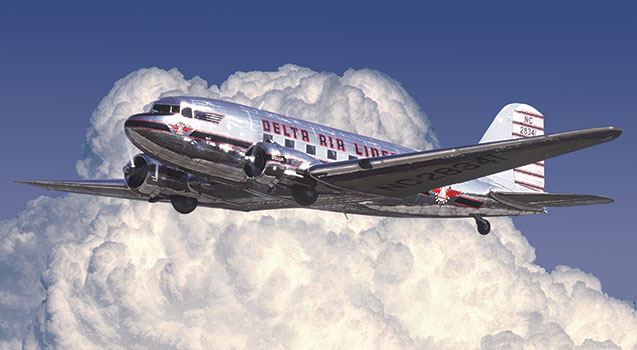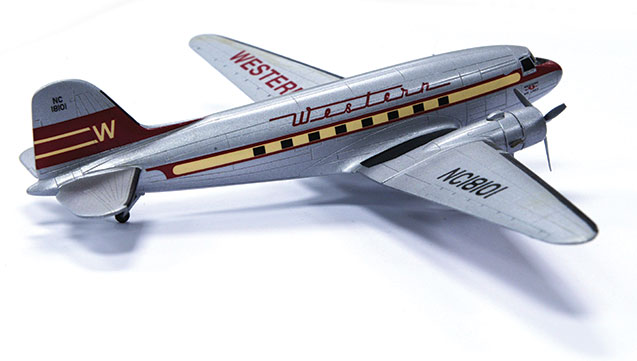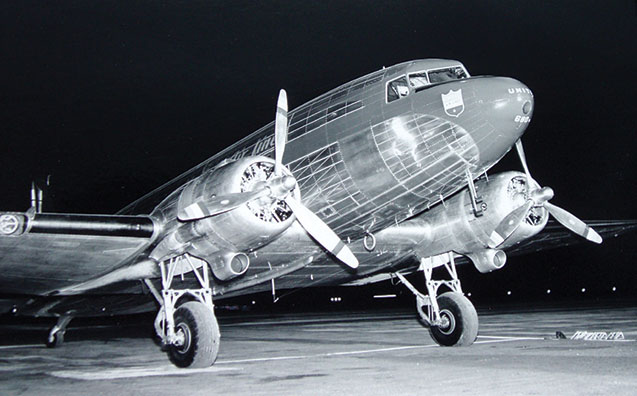Release #: Vol. 85, No. 2
March 01, 2016
Celebrating 85 Years - The DC-3: Airline Industry Game Changer
By John Perkinson, Staff Writer

Editor’s note: As ALPA prepares to celebrate its 85th anniversary this July, “Celebrating 85 Years,” a series of articles, takes a look at the issues, events, and people who helped shape today’s airline industry and the piloting profession.
It’s been said that few aircraft have had such a dramatic influence on the progress and advancement of airline travel as the Douglas DC-3. When matched up against iconic transports like the B-747 “jumbo jet” and the supersonic Concorde, it’s easy to discount this twin-engined tail dragger because of its age and size. Introduced in the mid-1930s, the original model carried a mere 21 passengers.
However, the DC-3 would transform the way the public viewed travel by air. These airplanes allowed airlines to rapidly expand their route structures to include communities that previously never had access to air travel. The DC-3 was the first passenger aircraft capable of flying nonstop from Chicago, Ill., to New York, N.Y. Most importantly for airlines, it was the first airplane to make passenger service profitable. Before the DC-3, carriers were often compelled to rely on mail subsidies to make ends meet.
With its durable design, the DC-3 could fly from coast to coast in the United States in as little as 18 hours, and it quickly became the backbone of many airline fleets. An aircraft for the ages, several hundred DC-3s are still in operation today.

A model of a Western DC-3 on display in ALPA’s Herndon, Va., offices.
Technological marvel
A tragic accident on March 31, 1931, compelled the airline industry to rethink aircraft design. A Transcontinental and Western Air (TWA) Fokker F-10A tri-motor, carrying legendary Notre Dame football coach Knute Rockne and seven others, crashed in eastern Kansas after one of the aircraft’s overhead wings separated during flight. The accident was attributed to deteriorating wood in the wing structure. TWA soon approached several manufacturers with specs for a new airplane. Among the requirements, TWA stipulated that the model would need to be able to maintain control during takeoff from any of the airports in the carrier’s network using a single engine.
Douglas experimented with its DC-1 and DC-2 models, the latter of which earned the manufacturer a Collier Trophy for outstanding achievement in flight. With both designs, Douglas moved the wing below the cabin, making it an integral component of the fuselage. The airplanes seated 12 and 14 passengers, respectively, and their improved operating performances quickly drew the attention of other airlines.
American Airways soon approached Douglas seeking a larger, faster version of the DC-2. The company responded with the 14-passenger Douglas Sleeper Transport (DST) and a 21-seat version for daytime operations. Otherwise known as the DC-3, this remarkable aircraft took flight on Dec. 17, 1935—32 years to the day after Orville Wright piloted the Wright Brothers’ first flight at Kitty Hawk, N.C. The DC-3 began airline service the following summer, and the first ticket on this American Airways flight was reportedly sold to film star Shirley Temple.
The early DC-3A was a technological marvel, reaching speeds of 230 mph and flying at heights of nearly 20,000 feet. Powered by two Wright R-1820 Cyclone engines, the aircraft had a 95-foot wingspan and was 65 feet long. The daytime version nearly doubled the capacity for passengers without adding to operating costs.
To strengthen its wing support, the DC-3 replaced the traditional system of spars and ribs with a honeycomb of dozens of metal boxes riveted together. With its cantilevered metal wings and retractable landing gear, the DC-3 also became a popular cargo aircraft, carrying loads of up to 6,000 pounds.
Over there
In fairness, some of the DC-3’s monumental success can be attributed to its unique circumstances. Mass-produced for World War II, the aircraft became a staple in troop transport. Military versions included the C-47 and the C-53, with a host of nicknames like the Dakota, the Skytrain, the Doug, and probably most popularly, the Gooney Bird.
The aircraft toted gliders and dropped paratroopers for Operation Market Garden, recalled in the Cornelius Ryan book and later the movie A Bridge Too Far. The airplane was an essential component of the D-Day invasion of Normandy, France. The C-47 also was used for the Berlin Airlift after the war.
Thousands of these aircraft were manufactured for the U.S., Canadian, and other allied militaries. When that war ended, the U.S. Army Air Forces and the Royal Canadian Air Force opted to sell many of these used airplanes at a discount to the airlines, which bought them to enlarge their flying networks. In addition, thousands of trained pilots came home from the war in search of work. It was a perfect opportunity for an industry still in its formative years.

A United Airlines DC-3A sits on the runway in Oakland, Calif., in 1940.
Legend in the making
Over the years, tales of the DC-3 have taken on almost mythic proportions. Former Air Line Pilot Editor C.V. Glines provided a perfect example in the November 1995 issue of Aviation History. He said, “Consider this true story about a C-47 that crash landed in full flight atop the Rosenlai Glacier in the Swiss Alps in 1946. The aircraft was not damaged as it slid to a slow stop during a blinding snowstorm. All aboard were eventually rescued; the Gooney was soon covered with snow and left to sink slowly into the glacier. Swiss glaciologists calculate that it will be spit out at the bottom of the glacier in 600 years.” Glines noted that these same Swiss glaciologists claim that the airplane should be intact and “could easily be made to fly again.”
Numerous carriers have equally amazing stories to share. Capital Airlines Flight 19 near Milwaukee, Wisc., on Aug. 7, 1949, experienced a mid-air collision with a Cessna 140. The DC-3 lost five feet from one of its wings and more than four feet of aileron, but it was able to land safely with its 23 passengers and crewmembers unharmed. The Cessna and its pilot were not so fortunate.
Southern Airways mechanics were conducting a maintenance check of a DC-3 in 1959 when they discovered a cracked bolt within a wing. Douglas engineers were asked to examine the bolt and determined that it was installed when the aircraft was built 22 years earlier. The bolt, which had a theoretical life of 16,000 hours, had actually endured 64,879 hours of operation before it broke.
Delta Air Lines purchased its first DC-3 in 1942 and logged 56,200 hours by the time the airplane was retired in 1960. During that period, it transported more than 400,000 passengers traveling approximately 8,430,000 miles.
Likewise, Eastern Air Lines’ fleet of DC-3s racked up a total of 83,584,318 miles—the same distance you’d cover if you traveled to the moon and back 175 times.
Decades after his historic first flight, 65-year-old Orville Wright inspected a TWA DC-3 that had landed at the airport in his hometown of Dayton, Ohio. He told a local news reporter, “They tell me that [the aircraft] is so soundproof that the passengers can talk to each other without shouting.” Although he didn’t go for a ride, he marveled at the airplane’s many features and the incredible progress that had been made in such a short period.
Orville was right. The DC-3 certainly is a far cry from the spruce and muslin contraption that carried him above the North Carolina sands. And today, the DC-3’s legacy stands the test of time, having set a standard for aircraft design, performance, reliability, and passenger comfort many years ago that forever changed aviation.
This article is from the March 2016 issue of Air Line Pilot magazine, the Official Journal of the Air Line Pilots Association, International—a monthly publication for all ALPA members.
-###-

